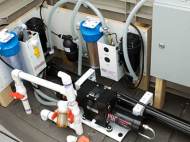MIT researchers developing portable solar-powered desalination system
 Although systems that remove salt from saltwater (desalination systems) have existed for decades, they are typically large-scale installations that require lots of energy to operate. A team of researchers from MIT has designed a solar-powered desalination system that could be rapidly deployed in remote areas, such as desert locations or farms and small villages in developing countries.
Although systems that remove salt from saltwater (desalination systems) have existed for decades, they are typically large-scale installations that require lots of energy to operate. A team of researchers from MIT has designed a solar-powered desalination system that could be rapidly deployed in remote areas, such as desert locations or farms and small villages in developing countries.
Led by Steven Dubowsky, a professor in both the Department of Mechanical Engineering and the Department of Aeronautics and Astronautics, and graduate students Amy Bilton and Leah Kelley, the group built a small prototype of the system last spring to test algorithms they had developed to run it. They have since demonstrated that the prototype is capable of producing almost 303 liters (80 gallons) of water a day in a variety of weather conditions.
The systems are also designed so that they can be cost-effectively assembled from standard parts and put into operation within hours using local human capital. Another objective is to create a device that can operate efficiently over a range of solar conditions. Unlike conventional solar-powered desalination systems that run on expensive, short-life batteries when it gets cloudy, this system is designed for “optimal control”. The system’s computer can change certain variables, such as the power of the pump or the position of the valves, to maximize water output in response to changes in sunshine, temperature and water demand. Various sensors are connected to a control computer that alerts operators when to make these changes. “If it’s very sunny, the system will work faster and produce more water, but even when it’s cloudy, it will still produce water”, said MechE graduate student and team member Kelley.
The system relies on reverse osmosis, a filtration method that removes molecules and ions such as salt from solutions by applying pressure to the fluid as it flows over a permeable membrane. This process begins as photons, or particles of light from the sun, fall onto a solar photovoltaic panel and excite electrons in that panel. This activity generates electric power that pushes seawater through various pumps until it is sent (at extremely high pressure) into a vessel that has a permeable membrane made of polymer material. As a result of the high pressure, the water that diffuses through the membrane has had minerals removed.
Dubowsky and his students are trying to ease the device operability as they gather data on how the system performs. Recently, they sent a small-scale unit to the Middle East for testing. In addition to trying to determine ways to produce more water, they are looking at how they might change the system’s design to make the system more durable.
They estimate that a larger version of the unit, which would cost about $8,000 to construct, could provide about 3,785 liters (1,000 gallons) of water per day. Dubowsky and his students also estimate that one C-130 cargo airplane could transport two dozen desalination units — enough to provide water for 10,000 people.









Good.
Dr.A.Jagadeesh Nellore(AP),India
Our University of Alabama patented solar desalination product uses no electricity, has no filters to replace, can be taken anywhere and extracts pure water from any contaminated water source. It removes radiation, fluoride, salt, pesticides, bacteria, dirt and other contaminants from any water. It aids people to be prepared for disasters. Made tough in the U.S.A.
Please visit us:
http://freshwater.ecogreenenergies.com
These units can also be placed together in arrays of literally any number of panels, as needed, to accommodate a desert farm or any remote area that needs water.